|
(11) | EP 0 274 821 B1 |
| (12) | EUROPEAN PATENT SPECIFICATION |
|
|
| (54) |
Benzopyran compounds, processes for their preparation and their pharmaceutical use Benzopyran-Verbindungen, Verfahren zu ihrer Herstellung und ihre pharmazeutische Verwendung Composés de benzopyrane, leurs procédé de préparation et leur utilisation pharmaceutique |
|
|
|||||||||||||||||||||||||||||||
|
||||||||||||||||||||||||||||||||
| Note: Within nine months from the publication of the mention of the grant of the European patent, any person may give notice to the European Patent Office of opposition to the European patent granted. Notice of opposition shall be filed in a written reasoned statement. It shall not be deemed to have been filed until the opposition fee has been paid. (Art. 99(1) European Patent Convention). |
[0001] The present invention relates to novel chromans and chromenes having pharmacological activity, to a process for preparing them, to pharmaceutical compositions containing them, and to their use in the treatment of mammals.
[0002] European Patent Publications 120 426, 120 428, 93 534, 76 075, 91 748 and, 93 535 disclose classes of chromans and chromenes that are described as having blood pressure lowering activity.
[0003] A further class of chromans and chromenes has now been discovered which contain a lactam ring that substitutes the chroman or chromene in the 4-position, the lactam ring having an hydroxy substituent. In addition, such chromans and chromenes have been found to have blood pressure lowering activity. It is also believed that these compounds have a mechanism of action which indicates that they are of potential use in the treatment of other cardiovascular disorders such as congestive heart failure, angina, peripheral vascular disease and cerebral vascular disease; and disorders associated with smooth muscle contraction of the gastro-intestinal tract (such as irritable bowel syndrome and diverticular disease), respiratory system (such as reversible airways obstruction and asthma), uterus (such as premature labour) and urinary tract (such as incontinence).
[0004] Accordingly, the present invention provides a compound of formula (I):
wherein:
either one of R₁ and R₂ is hydrogen and the other is selected from the class of C1-6 alkylcarbonyl, C1-6 alkoxycarbonyl, C1-6 alkylcarbonyloxy, C1-6 alkylhydroxymethyl, nitro, cyano, chloro, trifluoromethyl, C1-6 alkylsulphinyl, C1-6 alkylsulphonyl, C1-6 alkoxysulphinyl, C1-6 alkoxysulphonyl, C1-6 alkylcarbonylamino, C1-6 alkoxycarbonylamino, C1-6 alkyl-thiocarbonyl, C1-6 alkoxy-thiocarbonyl, C1-6 alkyl-thiocarbonyloxy, 1-mercapto C2-7 alkyl, formyl, or aminosulphinyl, aminosulphonyl or aminocarbonyl, the amino moiety being optionally substituted by one or two C1-6 alkyl groups, or C1-6 alkylsulphinylamino, C1-6 alkylsulphonylamino, C1-6 alkoxysulphinylamino or C1-6 alkoxysulphonylamino, or ethylenyl terminally substituted by C1-6 alkylcarbonyl, nitro or cyano, or -C(C1-6 alkyl)NOH or -C(C1-6 alkyl)NNH₂, or one of R₁ and R₂ is nitro, cyano or C1-3 alkylcarbonyl and the other is methoxy or amino optionally substituted by one or two C1-6 alkyl or by C2-7 alkanoyl;
one of R₃ and R₄ is hydrogen or C1-4 alkyl and the other is C1-4 alkyl or R₃ and R₄ together are C2-5 polymethylene;
either R₅ is hydrogen, hydroxy, C1-6 alkoxy or C1-7 acyloxy and R₆ is hydrogen or R₅ and R₆ together are a bond; and
n is 1 or 2;
the hydroxy group substituting the lactam group is other than at position a; and the substituted lactam group being trans to the R₅ group when R₅ is hydroxy, C1-6 alkoxy or C1-7 acyloxy; or a pharmaceutically acceptable salt thereof.
[0005] When one of R₁ and R₂ is hydrogen, the other is preferably selected from the class of CF₃, C1-6 alkylcarbonyl, C1-6 alkoxycarbonyl, nitro or cyano. In particular, when one of R₁ and R₂ is hydrogen, the other is preferably acetyl, nitro or cyano, especially nitro or cyano.
[0007] When one of R₁ and R₂ is nitro, cyano or C1-3 alkylcarbonyl, the other is preferably amino optionally substituted by one or two C1-6 alkyl or by C2-7 alkanoyl. In particular, when one of R₁ and R₂ is nitro, cyano or C1-3 alkylcarbonyl, the other is amino, methylamino, dimethylamino or acetylamino. Most preferably, one of R₁ and R₂ is nitro or cyano, especially cyano, and the other is amino.
[0008] When one of R₁ and R₂ is nitro, cyano or C1-3 alkylcarbonyl, it is preferred that R₁ is nitro, cyano or C1-3 alkylcarbonyl.
[0009] The alkyl groups or alkyl moieties of alkyl-containing groups for R₁ and R₂ are, preferably, methyl or ethyl.
[0010] Preferably, R₃ and R₄ are both C1-4 alkyl. In particular, they are both methyl or ethyl, preferably both methyl.
[0011] When R₅ is C1-6 alkoxy and R₆ is hydrogen, preferred examples of R₅ include methoxy and ethoxy, of which methoxy is more preferred. When R₅ is C1-7 acyloxy and R₆ is hydrogen, a preferred class of R₅ is unsubstituted carboxylic acyloxy, such as unsubstituted aliphatic acyloxy or benzoyloxy. However, it is more preferred that R₅ and R₆ together are a bond or that R₅ and R₆ are both hydrogen, or, in particular, that R₅ is hydroxy and R₆ is hydrogen.
[0012] The hydroxy substituent on the lactam ring is preferably at position 3- or 4- relative to the lactam nitrogen atom (position 1), when n = 1.
[0014] The compounds of formula (I) are preferably in pharmaceutically acceptable form. By pharmaceutically acceptable form is meant, inter alia, of a pharmaceutically acceptable level of purity excluding normal pharmaceutical additives such as diluents and carriers, and including no material considered toxic at normal dosage levels. A pharmaceutically acceptable level of purity will generally be at least 50% excluding normal pharmaceutical additives, preferably 75%, more preferably 90% and still more preferably 95%. One preferred pharmaceutically acceptable form is the crystalline form, including such form in a pharmaceutical composition.
[0015] Examples of a pharmaceutically acceptable salt of a compound of formula (I) include the acid addition salts of a compound of formula (I), wherein one or the other of R₁ and R₂ is an amino or an amino-containing group, for example the hydrochloride and hydrobromide salts.
[0016] The compounds of formula (I) and salts thereof may form pharmaceutically acceptable solvates, such as hydrates and these are included wherever a compound of formula (I) or a salt thereof is herein referred to.
[0017] The compounds of formula (I), have at least one asymmetric centre and, therefore, can exist in more than one isomeric form. The present invention extends to all such isomers individually and as mixtures, such as racemic modifications. The isomers may be separated one from another by conventional methods, such as by chromatography. Alternatively, an optically pure isomer may be prepared using chiral intermediates.
[0018] The hydroxy group substitutes the lactam ring in the α-configuration (wherein the hydroxy group is below the plane of the lactam ring as depicted in formula (I)).
[0019] Examples of compounds of formula (I) include the compounds prepared in the Examples hereinafter.
[0020] The present invention also provides a process for the preparation of a compound of formula (I), which comprises the reaction of a compound of formula (II):
with an anion of formula (III):
wherein Y is hydroxy, protected hydroxy or an oxo group; R₁ʹ is R₁ as hereinbefore defined or a group or atom convertible thereto, R₂ʹ is R₂ as hereinbefore defined or a group or atom convertible thereto, and R₃, R₄, R₅, and R₆ are as hereinbefore defined; and thereafter converting Y when protected hydroxy to hydroxy or reducing Y when oxo group to hydroxy;
or (when the hydroxy substituent on the lactam ring is in position b as depicted in formula (I));
with NH₃ to give a compound of formula (IV):
wherein the variable groups are as hereinbefore defined; and thereafter reacting the compound of formula (IV) with a compound of formula (V):
wherein n is as defined in formula (I);
and thereafter in the case where R₁ʹ is a group or atom convertible into R₁, converting the group or atom into R₁; in the case where R₂ʹ is a group or atom convertible into R₂, converting the group or atom into R₂; optionally converting R₁ or R₂ in the resulting compound of formula (I) into another R₁ or R₂; optionally converting the resulting compound of formula (I), wherein R₅ is hydroxy and R₆ is hydrogen, into another compound of formula (I) wherein R₅ is C1-6 alkoxy or C1-7 acyloxy and R₆ is hydrogen, or optionally dehydrating the resulting compound of formula (I), wherein R₅ is hydroxy and R₆ is hydrogen, so as to obtain the corresponding compound of formula (I), wherein R₅ and R₆ together are a bond, and optionally reducing the resulting compound of formula (I), wherein R₅ and R₆ together are a bond, so as to obtain the corresponding compound of formula (I) wherein R₅ and R₆ are both hydrogen; and optionally forming a pharmaceutically acceptable salt or solvate.
[0021] The reaction is preferably carried out in an inert solvent such as dimethylformamide or dimethylsulphoxide in the presence of a base such as sodium hydride.
[0022] Deprotection of Y when protected hydroxy to hydroxy may be carried out by conventional methods, such as hydrolysis.
[0023] Reduction of a Y oxo group to hydroxy may be carried out by conventional hydride reducing agents such as sodium borohydride in an inert solvent such as dimethylsulphoxide.
[0024] Examples of conversions of a group or atom for R₁ʹ or R₂ʹ into R₁ or R₂ are generally known in the art of aromatic chemistry. For example, if it is desired to obtain a compound of formula (I), wherein one of R₁ and R₂ is hydrogen and the other is nitro, it is possible to carry out the reaction between the compounds of formulae (II) and (III) with one of R₁ʹ and R₂ʹ being hydrogen and the other being acetamido and then to nitrate the resulting compound in conventional manner and subsequently to convert the acetamido group into a hydrogen atom by hydrolysis, diazotisation and decomposition in conventional manner.
[0025] If the optional conversion of the resulting compound of formula (I) wherein R₅ is hydroxy and R₆ is hydrogen, into another compound of formula (I) wherein R₅ is C1-7 acyloxy and R₆ is hydrogen, is to be carried out, then it is preferred first to protect any unsubstituted terminal amine that may be present for R₁ or R₂ and after the acylation reaction to convert the protected amino moiety into the required terminal amine. Examples of protecting groups and their addition and removal are generally known in the art.
Similarly, the hydroxy substituent on the lactam moiety is preferably protected; or Y is an oxo group which is then converted to hydroxy by reduction as hereinbefore described.
[0026] Examples of an optional conversion of R₁ or R₂ in the resulting compound of formula (I) into another R₁ or R₂, as hereinbefore defined, include the optional conversion of an α-hydroxyethyl group into acetyl by oxidation, the optional conversion of an amino group into a chloro atom by diazotisation and reaction with a chloride salt, the optional conversion of an amino group into an amino group substituted by one or two C1-6 alkyl or by C2-7 alkanoyl, or the optional conversion of a hydrogen atom into a nitro group by nitration.
[0027] The optional conversion of the resulting compound of formula (I) wherein R₅ is hydroxy and R₆ is hydrogen, into another compound of formula (I) wherein R₅ is C1-6 alkoxy or C1-7 acyloxy and R₆ is hydrogen, may be carried out respectively by alkylation using an alkyl iodide in an inert solvent, such as toluene, in the presence of a base, such as potassium hydroxide, or by acylation using a carboxylic acid chloride or anhydride in a non-hydroxylic solvent in the presence of a base such as trimethylamine, triethylamine or piperidine.
[0028] The optional dehydration of the resulting compound of formula (I) wherein R₅ is hydroxy and R₆ is hydrogen, so as to obtain the corresponding compound of formula (I) wherein R₅ and R₆ together are a bond, may be carried out under conventional dehydration conditions, for example, by using a dehydrating agent, such as sodium hydride, in an inert solvent, such as dry tetrahydrofuran, at reflux temperature. Again, the hydroxy substituent on the lactam moiety is preferably protected for such conversions.
[0029] The optional reduction of the resulting compound of formula (I) wherein R₅ and R₆ together are a bond, so as to obtain the corresponding compound of formula (I) wherein R₅ and R₆ are both hydrogen, may be carried out in conventional manner by catalytic hydrogenation using palladium on charcoal.
[0030] The optional formation of a pharmaceutically acceptable salt, when one or the other of R₁ and R₂ in the resulting compound of formula (I) is amino or an amino-containing group, may be carried out conventionally.
[0031] It will be appreciated that the above process results in a mixture of α- and β-hydroxy isomers in the lactam ring, which isomers may be separated to give the required α- isomer, by conventional methods, such as by chromatography.
[0032] The compounds of formula (II) are known compounds and can be prepared in accordance with the processes described in the aforementioned U.S. patents and European Patent Publications.
[0035] As mentioned previously, the compounds of formula (I) have been found to have blood-pressure lowering activity. They are therefore useful in the treatment of hypertension. They are also of potential use in the treatment of other disorders hereinbefore referred to.
[0036] The present invention accordingly provides a pharmaceutical composition which comprises a compound of formula (I) or a pharmaceutically acceptable salt thereof and a pharmaceutically acceptable carrier. In particular, the present invention provides an anti-hypertensive pharmaceutical composition which comprises an anti-hypertensive effective amount of a compound of formula (I) or a pharmaceutically acceptable salt thereof and a pharmaceutically acceptable carrier.
[0037] The compositions are preferably adapted for oral administration. However, they may be adapted for other modes of administration, for example parenteral administration for patients suffering from heart failure. Other alternative modes of administration include sublingual or transdermal administration, or inhalation, for the treatment of respiratory disorders.
[0038] In order to obtain consistency of administration it is preferred that a composition of the invention is in the form of a unit-dose. Suitable unit dose forms include tablets, capsules and powders in sachets or vials. Such unit dose forms may contain from 1 to 100 mg of a compound of the invention and more usually from 2 to 50 mg, for example 5 to 25 mg such as 6, 10, 15 or 20 mg. Such compositions may be administered from 1 to 6 times a day, more usually from 2 to 4 times a day, in a manner such that the daily dose is from 1 to 200 mg for a 70 kg human adult and more particularly fom 1 to 10 mg.
[0039] With the above indicated dosage range, no adverse toxicological effects are indicated with the compounds of the invention.
[0040] The compositions of the invention may be formulated with conventional excipients, such as a filler, a disintegrating agent, a binder, a lubricant, a flavouring agent. They are formulated in conventional manner, for example in a manner similar to that used for known anti-hypertensive agents, diuretics and β-blocking agents.
[0041] It is greatly preferred that the compound of formula (I) or a pharmaceutically acceptable salt thereof is administered in the form of a unit-dose composition, such as a unit dose oral or parenteral composition.
[0042] Such compositions are prepared by admixture and are suitably adapted for oral or parenteral administration, and as such may be in the form of tablets, capsules, oral liquid preparations, powders, granules, lozenges, reconstitutable powders, injectable and infusable solutions or suspensions or suppositories. Orally administrable compositions are preferred, in particular shaped oral compositions, since they are more convenient for general use.
[0043] Tablets and capsules for oral administration are usually presented in a unit dose, and contain conventional excipients such as binding agents, fillers, diluents, tabletting agents, lubricants, disintegrants, colourants, flavourings, and wetting agents. The tablets may be coated according to well known methods in the art.
[0044] Suitable fillers for use include cellulose, mannitol, lactose and other similar agents. Suitable disintegrants include starch, polyvinylpyrrolidone and starch derivatives such as sodium starch glycollate. Suitable lubricants include, for example, magnesium stearate. Suitable pharmaceutically acceptable wetting agents include sodium lauryl sulphate.
[0045] These solid oral compositions may be prepared by conventional methods of blending, filling, tabletting or the like. Repeated blending operations may be used to distribute the active agent throughout those compositions employing large quantities of fillers. Such operations are, of course, conventional in the art.
[0046] Oral liquid preparations may be in the form of, for example, aqueous or oily suspensions, solutions, emulsions, syrups, or elixirs, or may be presented as a dry product for reconstitution with water or other suitable vehicle before use. Such liquid preparations may contain conventional additives such as suspending agents, for example sorbitol, syrup, methyl cellulose, gelatin, hydroxyethylcellulose, carboxymethyl cellulose, aluminium stearate gel or hydrogenated edible fats, emulsifying agents, for example lecithin, sorbitan monooleate, or acacia; non-aqueous vehicles (which may include edible oils), for example, almond oil, fractionated coconut oil, oily esters such as esters of glycerine, propylene glycol, or ethyl alcohol; preservatives, for example methyl or propyl p-hydroxybenzoate or sorbic acid, and if desired conventional flavouring or colouring agents.
[0047] Oral formulations also include conventional sustained release formulations, such as tablets or granules having an enteric coating.
[0048] For parenteral administration, fluid unit dose forms are prepared containing a compound of the present invention and a sterile vehicle. The compound, depending on the vehicle and the concentration, can be either suspended or dissolved. Parenteral solutions are normally prepared by dissolving the compound in a vehicle and filter sterilising before filling into a suitable vial or ampoule and sealing. Advantageously, adjuvants such as a local anaesthetic, preservatives and buffering agents are also dissolved in the vehicle. To enhance the stability, the composition can be frozen after filling into the vial and the water removed under vacuum.
[0049] Parenteral suspensions are prepared in substantially the same manner except that the compound is suspended in the vehicle instead of being dissolved and sterilised by exposure to ethylene oxide before suspending in the sterile vehicle. Advantageously, a surfactant or wetting agent is included in the composition to facilitate uniform distribution of the compound of the invention.
[0050] In addition such compositions may contain further active agents such as anti-hypertensive agents and diuretics.
[0051] As is common practice, the compositions will usually be accompanied by written or printed directions for use in the medical treatment concerned.
[0052] The present invention further provides a compound of the formula (I) or a pharmaceutically acceptable salt thereof for use as an active therapeutic substance, in particular in the treatment of hypertension.
[0053] The present invention yet further provides the use of a compound of formula (I) in the manufacture of a medicament for treating hypertension in mammals including man, which comprises administering to the suffering mammal an anti-hypertensive effective amount of a compound of formula (I) or a pharmaceutically acceptable salt thereof or a pharmaceutical composition of the invention.
EXAMPLE 1
(±)-Trans-6-Cyano-3,4-dihydro-2,2-dimethyl-4-(3-hydroxy-2-oxo-1-pyrrolidinyl)-2H-1-benzopyran-3-ol
[0056] Sodium hydride (80% dispersion in oil, 1.6 g) was added to a solution of (±)-6-cyano-3,4-dihydro-2,2-dimethyl-trans-3-bromo-4-hydroxy-2H-1-benzopyran (14.86 g) in DMSO (100 mL) and the mixture stirred under a dry atmosphere for 45 min when a solution of the 3,4-epoxide resulted.The solution was then cooled to ca 10°C before 3-trimethylsilyloxy-2-pyrrolidinone (12.86 g) was added along with further DMSO (20 mL) and sodium hydride (2.35 g). The mixture was stirred at room temperature for 22 h after which it was poured into water (600 mL) and extracted with ethyl acetate several times. The combined extracts were washed with water (4×150 mL), brine and dried (Na₂SO₄). Evaporation gave a crystalline greenish solid (14.4 g) which was triturated with a little ethyl acetate before filtering under suction and washing with a little ethyl acetate followed by 50% ether/ethyl acetate. The crystalline material (7.9 g, 50%) appeared to be a ca 50:50 mixture of the 3ʹ-hydroxy isomers.
[0057] Separation of a small sample on a hypersil 250mm × 7mm using a gradient elution technique with CH₂Cl₂ → CH₂Cl₂- MeOH (10%) at 5 mL/min, on an LKB HPLC system at 252 nm, gave the (±)-3ʹβ-hydroxy compound mp 282-284°C (from MeOH); NMR (CD₃OD) δ 1.27 (s, 3H), 1.51 (s, 3H), 1.97 (m, 1H), 2.45 (m, 1H), 3.06 (m, 1H), 3.42 (m, 1H), 3.89 (d, J=10, 1H), 4.53 (t, J=8,8, 1H), 5.10 (m, 1H), 6.92 (d, J=9, 1H), 7.28 (br.s, 1H), 7.52 (q, J=9,2, 1H), and the (±)-3ʹα-hydroxy compound (E1) mp 238-242°C; NMR (CD₃OD) δ 1.27 (s, 3H), 1.50 (s, 3H), 1.89 (m, 1H), 2.49 (m, 1H), 3.00 (m, 1H), 3.32 (m, 1H), 3.78 (d, J=10, 1H), 4.47 (t, J=8, 1H), 5.13 (d, J=10, 1H), 6.93 (d, J=9, 1H), 7.40 (d, J=2, 1H), 7.53 (q, J=9,2, 1H).
EXAMPLE 2
(±)-Trans-6-Cyano-3,4-dihydro-2,2-dimethyl-4-(4-hydroxy-2-oxo-1-pyrrolidinyl)-2H-1-benzopyran-3-ol
[0059] To a stirred solution of (±)-trans-6-cyano-3,4-dihydro-2,2-dimethyl-4-(2,4-dioxo-1-pyrrolidinyl)-2H-1-benzopyran -3-ol (0.9 g) in dry DMSO under N₂, was added NaBH₄ (0.11 g). The reaction was stirred for 3 h at room temperature. Water (100 mL) was added and the aqueous phase extracted with EtOAc. The organic layer was washed with H₂O and brine, dried over MgSO₄, filtered and evaporated to give the crude product (0.5 g) as an orange solid. This mixture was chromatographed (chromatotron CHCl₃ → CHCl₃-10% MeOH gradient elution; 2 mm silica gel) to give two fractions.
[0060] Recrystallization of the least polar component (EtOAc-EtOH) gave the (±)-4ʹ-β-hydroxy compound (0.16 g) mp 256-259°C; NMR [(CD₃)₂SO] δ 1.19 (s, 3H), 1.44 (s, 3H), 2.22 (q, J=18,4, 1H), 2.78 (q, J=18,6, 1H), 3.19 (m, 2H), 3.76 (m, 1H), 4.38 (m, 1H), 4.91 (m, 1H), 5.27 (d, J=4, 1H exchangeable with D₂O), 5.69 (d, J=6, 1H exchangeable with D₂O), 6.93 (d, J=8, 1H), 7.38 (narrow m, 1H), 7.60 (q, J=8,2, 1H).
[0061] In a similar recrystallisation the more polar component gave the (±)-4ʹ-α-hydroxy compound (0.05 g) (E2) mp 259-263°C; NMR [(CD₃)₂SO] δ 1.21 (s, 3H), 1.46 (s, 3H), 2.24 (d, J=18, 1H), 2.70 (m, 2H), 3.50 (q, J=10,4, 1H), 3.63 (q, J=10,6, 1H), 4.31 (m, 1H), 5.00 (d, J=10, 1H), 5.26 (d, J=4, 1H exchangeable with D₂O), 5.73 (d, J=6, 1H exchangeable with D₂O), 6.94 (d, J=9, 1H), 7.38 (narrow m, 1H), 7.61 (q, J=9,2, 1H).
EXAMPLE 3
(-)-Trans-6-Cyano-3,4-dihydro-2,2-dimethyl-4-(4-hydroxy-2-oxo-1-pyrrolidinyl)-2H-1-benzopyran-3-ol
[0063] A mixture of (+)-trans-4-amino-6-cyano-3,4-dihydro-2,2-dimethyl-2H-1-benzopyran-3-ol (5.2g) ([α]D²⁶ + 82.9° (c,1.0, methanol)) and 3,4-epoxybutyric acid (10.5g) in ethanol (85 ml) was stirred and refluxed for 24hr. The solution was cooled and evaporated to dryness. The residue obtained crystallized on addition of ethyl acetate-diethyl ether. Filtration gave a white powder (3.54g) which was chromatographed on silica gel using chloroform → 15% methanol-chloroform in a gradient elution. Recrystallisation of the least polar diastereoisomer (ethyl acetate-ethanol) gave the (-)-4ʹ-β-hydroxy compound (0.345g), mp 265-266°C(d); [α]D²⁵ -34.7° (c,1.0, methanol).
[0064] Recrystallisation of the more polar diastereoisomer (ethyl acetate-ethanol) gave the (-)-4ʹ-α-hydroxy compound (1.25g) (E3), mp 260-261°C; [α]D²⁵ - 13.6° (c, 1.0, methanol).
PHARMACOLOGICAL DATA
[0065] Systolic blood pressures were recorded by a modification of the tail cuff method described by I.M. Claxton, M.G. Palfreyman, R.H. Poyser, R.L. Whiting, European Journal of Pharmacology, 37, 179 (1976). A W+W BP recorder, model 8005 was used to display pulses. Prior to all measurements rats were placed in a heated environment (33.5 ± 0.5°C) before transfer to a restraining cage. Each determination of blood pressure was the mean of at least 6 readings. Spontaneously hypertensive rats (ages 12-18 weeks) with systolic blood pressures >180 mmHg were considered hypertensive.
1. A compound of formula (I):
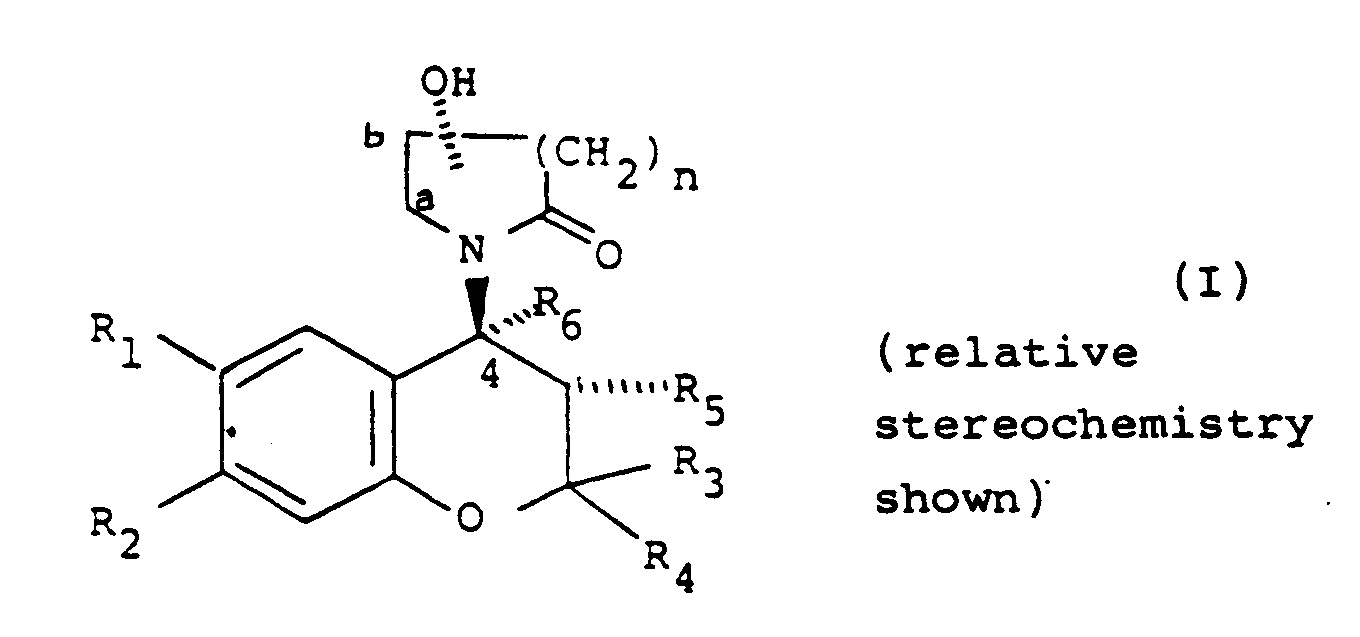
wherein:
either one of R₁ and R₂ is hydrogen and the other is selected from the class of C1-6 alkylcarbonyl, C1-6 alkoxycarbonyl, C1-6 alkylcarbonyloxy, C1-6 alkylhydroxymethyl, nitro, cyano, chloro, trifluoromethyl, C1-6 alkylsulphinyl, C1-6 alkylsulphonyl, C1-6 alkoxysulphinyl, C1-6 alkoxysulphonyl, C1-6 alkylcarbonylamino, C1-6 alkoxycarbonylamino, C1-6 alkyl-thiocarbonyl, C1-6 alkoxy-thiocarbonyl, C1-6 alkyl-thiocarbonyloxy, 1-mercapto C2-7 alkyl, formyl, or aminosulphinyl, aminosulphonyl or aminocarbonyl, the amino moiety being optionally substituted by one or two C1-6 alkyl groups, or C1-6 alkylsulphinylamino, C1-6 alkylsulphonylamino, C1-6 alkoxysulphinylamino or C1-6 alkoxysulphonylamino, or ethylenyl terminally substituted by C1-6 alkylcarbonyl, nitro or cyano, or -C(C1-6 alkyl)NOH or -C(C1-6 alkyl)NNH₂, or one of R₁ and R₂ is nitro, cyano or C1-3 alkylcarbonyl and the other is methoxy or amino optionally substituted by one or two C1-6 alkyl or by C2-7 alkanoyl;
one of R₃ and R₄ is hydrogen or C1-4 alkyl and the other is C1-4 alkyl or R₃ and R₄ together are C2-5 polymethylene;
either R₅ is hydrogen, hydroxy, C1-6 alkoxy or C1-7 carboxylic acyloxy and R₆ is hydrogen or R₅ and R₆ together are a bond; and
n is 1 or 2;
the hydroxy group substituting the lactam group is other than at position a; and the substituted lactam group being trans to the R₅ group when R₅ is hydroxy, C1-6 alkoxy or C1-7 acyloxy; or a pharmaceutically acceptable salt thereof.
wherein:
either one of R₁ and R₂ is hydrogen and the other is selected from the class of C1-6 alkylcarbonyl, C1-6 alkoxycarbonyl, C1-6 alkylcarbonyloxy, C1-6 alkylhydroxymethyl, nitro, cyano, chloro, trifluoromethyl, C1-6 alkylsulphinyl, C1-6 alkylsulphonyl, C1-6 alkoxysulphinyl, C1-6 alkoxysulphonyl, C1-6 alkylcarbonylamino, C1-6 alkoxycarbonylamino, C1-6 alkyl-thiocarbonyl, C1-6 alkoxy-thiocarbonyl, C1-6 alkyl-thiocarbonyloxy, 1-mercapto C2-7 alkyl, formyl, or aminosulphinyl, aminosulphonyl or aminocarbonyl, the amino moiety being optionally substituted by one or two C1-6 alkyl groups, or C1-6 alkylsulphinylamino, C1-6 alkylsulphonylamino, C1-6 alkoxysulphinylamino or C1-6 alkoxysulphonylamino, or ethylenyl terminally substituted by C1-6 alkylcarbonyl, nitro or cyano, or -C(C1-6 alkyl)NOH or -C(C1-6 alkyl)NNH₂, or one of R₁ and R₂ is nitro, cyano or C1-3 alkylcarbonyl and the other is methoxy or amino optionally substituted by one or two C1-6 alkyl or by C2-7 alkanoyl;
one of R₃ and R₄ is hydrogen or C1-4 alkyl and the other is C1-4 alkyl or R₃ and R₄ together are C2-5 polymethylene;
either R₅ is hydrogen, hydroxy, C1-6 alkoxy or C1-7 carboxylic acyloxy and R₆ is hydrogen or R₅ and R₆ together are a bond; and
n is 1 or 2;
the hydroxy group substituting the lactam group is other than at position a; and the substituted lactam group being trans to the R₅ group when R₅ is hydroxy, C1-6 alkoxy or C1-7 acyloxy; or a pharmaceutically acceptable salt thereof.
2. A compound according to claim 1 wherein R₁ is nitro, cyano or C1-3 alkylcarbonyl and R₂ is hydrogen.
3. A compound according to claim 1 or 2 wherein R₃ and R₄ are both methyl groups.
4. A compound according to any one of claims 1, 2 or 3 wherein R₅ is hydroxy and R₆ is
hydrogen.
5. A compound according to any one of claims 1 to 4 wherein the hydroxy substituent on
the lactam ring is at position 3- or 4- relative to the lactam nitrogen atom, and
n is 1.
6. A compound according to claim 1 which is (±)-trans-6-cyano-3,4-dihydro-2,2-dimethyl-4-(3α-hydroxy-2-oxo-1-pyrrolidinyl)-2H-1-benzopyran-3-ol;
(±)-trans-6-cyano-3,4-dihydro-2,2-dimethyl-4-(4α-hydroxy-2-oxo-1-pyrrolidinyl)-2H-1-benzopyran-3-ol or the single (-)-isomer thereof.
(±)-trans-6-cyano-3,4-dihydro-2,2-dimethyl-4-(4α-hydroxy-2-oxo-1-pyrrolidinyl)-2H-1-benzopyran-3-ol or the single (-)-isomer thereof.
7. A compound according to any one of claims 1 to 6, in pharmaceutically acceptable form.
8. A process for the preparation of a compound according to claim 1, which process comprises
i) the reaction of a compound of formula (II):

with an anion of formula (III):
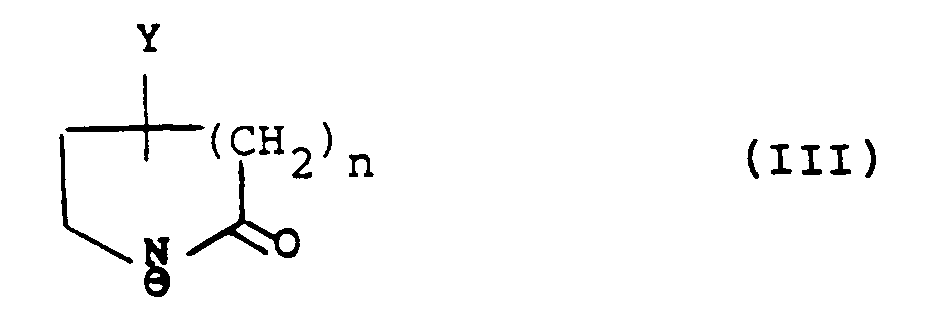
wherein Y is hydroxy, protected hydroxy or an oxo group; R₁ʹ is R₁ as defined in claim 1, or a group or atom convertible thereto, R₂ʹ is R₂ as defined in claim 1, or a group or atom convertible thereto, and R₃, R₄, R₅, and R₆ are as defined in claim 1, and thereafter converting Y when protected hydroxy to hydroxy or reducing Y when oxo group to hydroxy;
or ii) (when the hydroxy substituent on the lactam ring is in position b as depicted in formula (I)); the reaction of a compound of formula (II) with NH₃ to give a compound of formula (IV):
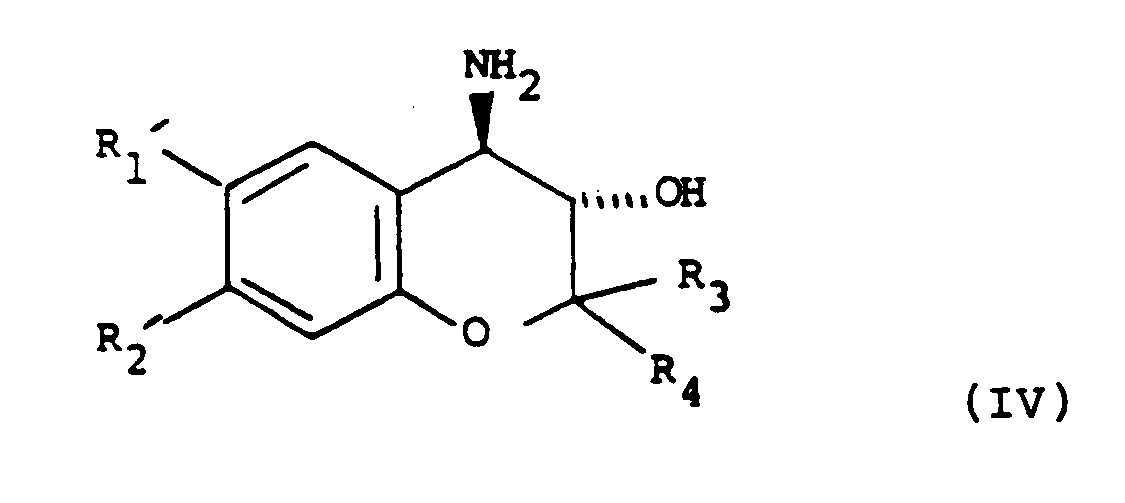
wherein the variable groups are as defined in claim 1, and thereafter reacting the compound of formula (IV) with a compound of formula (V):

wherein n is as defined in claim 1;
and thereafter in the case where R₁ʹ is a group or atom convertible into R₁, converting the group or atom into R₁; in the case where R₂ʹ is a group or atom convertible into R₂, converting the group or atom into R₂; optionally converting R₁ or R₂ in the resulting compound of formula (I) into another R₁ or R₂; optionally converting the resulting compound of formula (I), wherein R₅ is hydroxy and R₆ is hydrogen, into another compound of formula (I) wherein R₅ is C1-6 alkoxy or C1-7 acyloxy and R₆ is hydrogen, or optionally dehydrating the resulting compound of formula (I), wherein R₅ is hydroxy and R₆ is hydrogen, so as to obtain the corresponding compound of formula (I), wherein R₅ and R₆ together are a bond, and optionally reducing the resulting compound of formula (I), wherein R₅ and R₆ together are a bond, so as to obtain the corresponding compound of formula (I) wherein R₅ and R₆ are both hydrogen; and optionally forming a pharmaceutically acceptable salt or solvate.
with an anion of formula (III):
wherein Y is hydroxy, protected hydroxy or an oxo group; R₁ʹ is R₁ as defined in claim 1, or a group or atom convertible thereto, R₂ʹ is R₂ as defined in claim 1, or a group or atom convertible thereto, and R₃, R₄, R₅, and R₆ are as defined in claim 1, and thereafter converting Y when protected hydroxy to hydroxy or reducing Y when oxo group to hydroxy;
or ii) (when the hydroxy substituent on the lactam ring is in position b as depicted in formula (I)); the reaction of a compound of formula (II) with NH₃ to give a compound of formula (IV):
wherein the variable groups are as defined in claim 1, and thereafter reacting the compound of formula (IV) with a compound of formula (V):
wherein n is as defined in claim 1;
and thereafter in the case where R₁ʹ is a group or atom convertible into R₁, converting the group or atom into R₁; in the case where R₂ʹ is a group or atom convertible into R₂, converting the group or atom into R₂; optionally converting R₁ or R₂ in the resulting compound of formula (I) into another R₁ or R₂; optionally converting the resulting compound of formula (I), wherein R₅ is hydroxy and R₆ is hydrogen, into another compound of formula (I) wherein R₅ is C1-6 alkoxy or C1-7 acyloxy and R₆ is hydrogen, or optionally dehydrating the resulting compound of formula (I), wherein R₅ is hydroxy and R₆ is hydrogen, so as to obtain the corresponding compound of formula (I), wherein R₅ and R₆ together are a bond, and optionally reducing the resulting compound of formula (I), wherein R₅ and R₆ together are a bond, so as to obtain the corresponding compound of formula (I) wherein R₅ and R₆ are both hydrogen; and optionally forming a pharmaceutically acceptable salt or solvate.
9. A pharmaceutical composition comprising a compound according to any one of claims
1 to 7, and a pharmaceutically acceptable carrier.
10. The use of a compound according to any one of Claims 1 to 7 in the manufacture of
a medicament for treating hypertension and/or congestive heart failure and/or angina
and/or peripheral vascular disease and/or cerebral vascular disease and/or diseases
associated with smooth muscle contraction of the gastrointestinal tract and/or respiratory
system and/or uterus and/or urinary tract.
1. Verbindung der Formel (I):
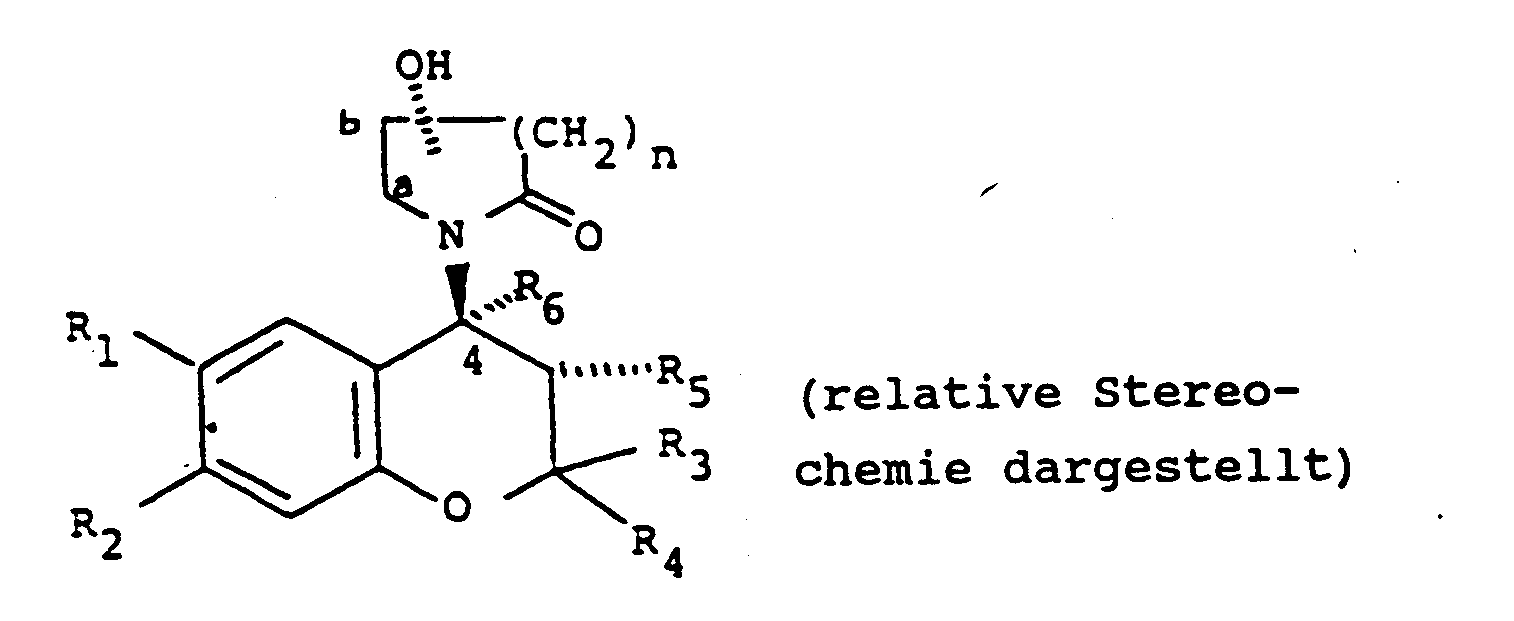
in der:
entweder einer der Reste R₁ und R₂ ein Wasserstoffatom bedeutet und der andere ausgewählt ist aus der Klasse C₁₋₆-Alkylcarbonyl-, C₁₋₆-Alkoxycarbonyl-, C₁₋₆-Alkylcarbonyloxy-, C₁₋₆-Alkylhydroxymethylreste, Nitrogruppe, Cyanogruppe, Chloratom, Trifluormethylgruppe, C₁₋₆-Alkylsulfinyl-, C₁₋₆-Alkylsulfonyl-, C₁₋₆-Alkoxysulfinyl-, C₁₋₆-Alkoxysulfonyl-, C₁₋₆-Alkylcarbonylamino-, C₁₋₆-Alkoxycarbonylamino-, C₁₋₆-Alkylthiocarbonyl-, c₁₋₆-Alkoxythiocarbonyl-, C₁₋₆-Alkylthiocarbonyloxy-, 1-Mercapto-C₂₋₇-alkylreste, Formylgruppe oder Aminosulfinyl-, Aminosulfonyl- oder Aminocarbonylgruppen, in denen die Aminogruppe gegebenenfalls mit ein oder zwei C₁₋₆-Alkylresten substituiert ist oder C₁₋₆-Alkylsulfinylamino-, C₁₋₆-Alkylsulfonylamino-, C₁₋₆-Alkoxysulfinylamino- oder C₁₋₆-Alkoxysulfonylaminoreste oder eine Ethylenylgruppe, die endständig mit einem C₁₋₆-Alkylcarbonylrest, einer Nitrogruppe oder Cyanogruppe substituiert ist, oder Resten der Formel -C(C₁₋₆-Alkyl)NOH oder -C(C₁₋₆-Alkyl)NNH₂, oder einer der Reste R₁ und R₂ eine Nitro- oder Cyanogruppe oder einen C₁₋₃-Alkylcarbonylrest bedeutet und der andere eine Methoxy- oder Aminogruppe darstellt, die gegebenenfalls mit ein oder zwei C₁₋₆-Alkylresten oder mit C₂₋₇-Alkanoylresten substituiert ist;
einer der Reste R₃ und R₄ ein Wasserstoffatom oder einen C₁-₄-Alkylrest darstellt und der andere einen C₁₋₄-Alkylrest bedeutet oder R₃ und R₄ zusammengenommen einen C₂₋₅-Polymethylenrest darstellen;
entweder R₅ ein Wasserstoffatom, eine Hydroxylgruppe, einen C₁₋₆-Alkoxy- oder C₁₋₇-Carboxylacyloxyrest bedeutet und R₆ ein Wasserstoffatom darstellt oder R₅ und R₆ zusammengenommen eine Bindung bedeuten und
n 1 oder 2 ist;
wobei die als Substituent der Lactamgruppe vorliegende Hydroxylgruppe nicht Stellung a einnimmt; und die substituierte Lactamgruppe sich in trans-Stellung zum R₅-Rest befindet, wenn R₅ eine Hydroxylgruppe, einen C₁₋₆-Alkoxy- oder C₁₋₇-Acyloxylrest bedeutet; oder ein pharmazeutisch verträgliches Salz davon.
in der:
entweder einer der Reste R₁ und R₂ ein Wasserstoffatom bedeutet und der andere ausgewählt ist aus der Klasse C₁₋₆-Alkylcarbonyl-, C₁₋₆-Alkoxycarbonyl-, C₁₋₆-Alkylcarbonyloxy-, C₁₋₆-Alkylhydroxymethylreste, Nitrogruppe, Cyanogruppe, Chloratom, Trifluormethylgruppe, C₁₋₆-Alkylsulfinyl-, C₁₋₆-Alkylsulfonyl-, C₁₋₆-Alkoxysulfinyl-, C₁₋₆-Alkoxysulfonyl-, C₁₋₆-Alkylcarbonylamino-, C₁₋₆-Alkoxycarbonylamino-, C₁₋₆-Alkylthiocarbonyl-, c₁₋₆-Alkoxythiocarbonyl-, C₁₋₆-Alkylthiocarbonyloxy-, 1-Mercapto-C₂₋₇-alkylreste, Formylgruppe oder Aminosulfinyl-, Aminosulfonyl- oder Aminocarbonylgruppen, in denen die Aminogruppe gegebenenfalls mit ein oder zwei C₁₋₆-Alkylresten substituiert ist oder C₁₋₆-Alkylsulfinylamino-, C₁₋₆-Alkylsulfonylamino-, C₁₋₆-Alkoxysulfinylamino- oder C₁₋₆-Alkoxysulfonylaminoreste oder eine Ethylenylgruppe, die endständig mit einem C₁₋₆-Alkylcarbonylrest, einer Nitrogruppe oder Cyanogruppe substituiert ist, oder Resten der Formel -C(C₁₋₆-Alkyl)NOH oder -C(C₁₋₆-Alkyl)NNH₂, oder einer der Reste R₁ und R₂ eine Nitro- oder Cyanogruppe oder einen C₁₋₃-Alkylcarbonylrest bedeutet und der andere eine Methoxy- oder Aminogruppe darstellt, die gegebenenfalls mit ein oder zwei C₁₋₆-Alkylresten oder mit C₂₋₇-Alkanoylresten substituiert ist;
einer der Reste R₃ und R₄ ein Wasserstoffatom oder einen C₁-₄-Alkylrest darstellt und der andere einen C₁₋₄-Alkylrest bedeutet oder R₃ und R₄ zusammengenommen einen C₂₋₅-Polymethylenrest darstellen;
entweder R₅ ein Wasserstoffatom, eine Hydroxylgruppe, einen C₁₋₆-Alkoxy- oder C₁₋₇-Carboxylacyloxyrest bedeutet und R₆ ein Wasserstoffatom darstellt oder R₅ und R₆ zusammengenommen eine Bindung bedeuten und
n 1 oder 2 ist;
wobei die als Substituent der Lactamgruppe vorliegende Hydroxylgruppe nicht Stellung a einnimmt; und die substituierte Lactamgruppe sich in trans-Stellung zum R₅-Rest befindet, wenn R₅ eine Hydroxylgruppe, einen C₁₋₆-Alkoxy- oder C₁₋₇-Acyloxylrest bedeutet; oder ein pharmazeutisch verträgliches Salz davon.
2. Verbindung nach Anspruch 1, wobei R₁ eine Nitrogruppe, Cyanogruppe oder einen C₁₋₃-Alkylcarbonylrest
darstellt und R₂ ein Wasserstoffatom bedeutet.
3. Verbindung nach Anspruch 1 oder 2, wobei R₃ und R₄ jeweils eine Methylgruppe darstellen.
4. Verbindung nach einem der Ansprüche 1, 2 oder 3, wobei R₅ eine Hydroxylgruppe bedeutet
und R₆ ein Wasserstoffatom darstellt.
5. Verbindung nach einem der Ansprüche 1 bis 4, wobei der Hydroxylgruppensubstituent
am Lactamring sich in 3- oder 4-Stellung in bezug auf das Lactam-Stickstoffatom befindet
und n 1 ist.
6. Verbindung nach Anspruch 1, nämlich (±)-trans-6-Cyano-3,4-dihydro-2,2-dimethyl-4-(3α-hydroxy-2-oxo-1-pyrrolidinyl)-2H-1-benzopyran-3-ol;
(±)-trans-6-Cyano-3,4-dihydro-2,2-dimethyl-4-(4α-hydroxy-2-oxo-1-pyrrolidinyl)-2H-1-benzopyran-3-ol oder das einfache (-)-Isomer davon.
(±)-trans-6-Cyano-3,4-dihydro-2,2-dimethyl-4-(4α-hydroxy-2-oxo-1-pyrrolidinyl)-2H-1-benzopyran-3-ol oder das einfache (-)-Isomer davon.
7. Verbindung nach einem der Ansprüche 1 bis 6 in pharmazeutisch verträglicher Form.
8. Verfahren zur Herstellung einer Verbindung nach Anspruch 1, wobei das Verfahren umfaßt
i) die Umsetzung einer Verbindung der Formel (II):
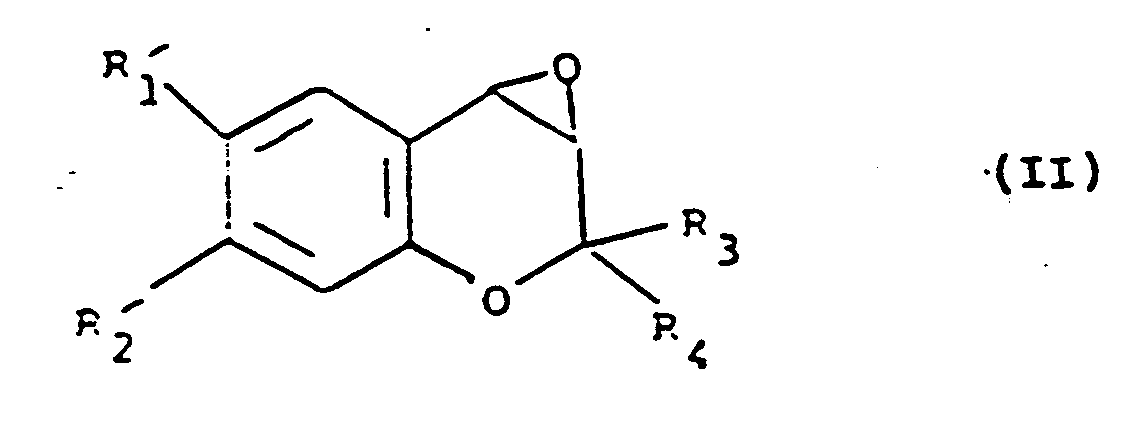
mit einem Anion der Formel (III):
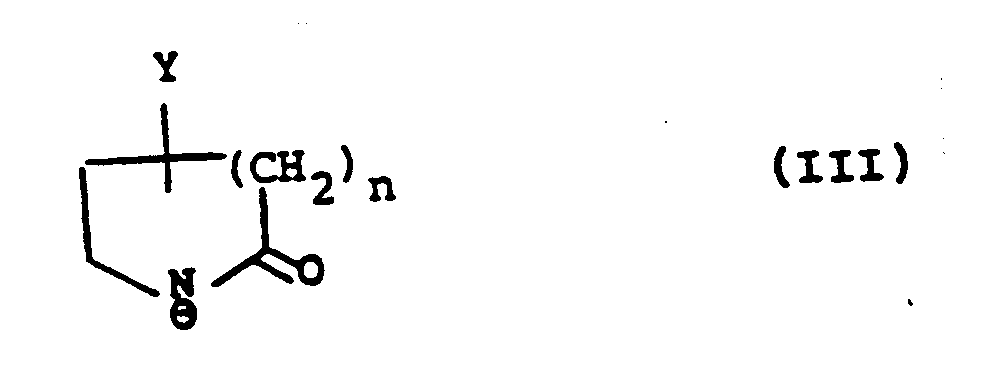
in denen Y eine Hydroxylgruppe, geschützte Hydroxylgruppe oder eine Oxogruppe bedeutet; R₁' einen Rest R₁ gemäß Anspruch 1 darstellt oder einen/ein dazu umwandelbaren(s) Rest oder Atom, R₂' einen Rest R₂ gemäß Anspruch 1 darstellt oder einen/ein dazu umwandelbaren(s) Rest oder Atom, und R₃, R₄, R₅ und R₆ gemäß Anspruch 1 definiert sind und anschließend Umwandeln von Y, wenn die Hydroxylgruppe geschützt ist, zur Hydroxylgruppe oder Reduzieren von Y, wenn es als Oxogruppe vorliegt, zur Hydroxylgruppe;
oder ii) (wenn der Hydroxylgruppensubstituent am Lactamring sich in der in Formel (I) ausgewiesenen Stellung b befindet) Umsetzung einer Verbindung der Formel (II) mit NH₃ zu einer Verbindung der Formel (IV):
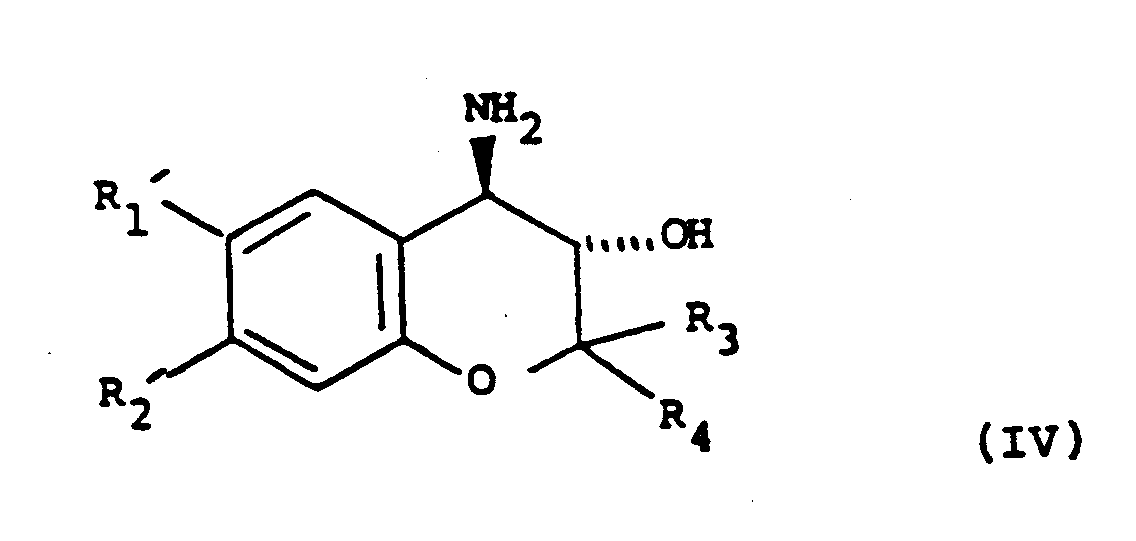
in der die variablen Reste gemäß Anspruch 1 definiert sind, und anschließend Umsetzung der Verbindung von Formel (IV) mit einer Verbindung der Formel (V):

in der n wie in Anspruch 1 definiert ist;
und anschließend, falls R₁' einen/ein zum Rest R₁ umwandelbaren(s) Rest oder Atom bedeutet, Umwandeln des Restes oder des Atoms in R₁; falls R₂' einen/ein zum Rest R₂ umwandelbaren Rest oder Atom darstellt, Umwandeln des Restes oder Atoms in R₂; gegebenenfalls Umwandeln von R₁ oder R₂ in der sich ergebenden Verbindung der Formel (I) in andere Reste R₁ oder R₂; gegebenenfalls Umwandeln der sich ergebenden Verbindung der Formel (I), in der R₅ eine Hydroxylgruppe bedeutet und R₆ ein Wasserstoffatom darstellt, in eine andere Verbindung der Formel (I), in der R₅ einen C₁₋₆-Alkoxyrest oder C₁₋₇-Acyloxyrest bedeutet und R₆ ein Wasserstoffatom darstellt, oder gegebenenfalls Dehydratisieren der sich ergebenden Verbindung von Formel (I), in der R₅ eine Hydroxylgruppe bedeutet und R₆ ein Wasserstoffatom darstellt, so daß die entsprechende Verbindung der Formel (I) erhalten wird, in der R₅ und R₆ zusammengenommen eine Bindung darstellen, und gegebenenfalls Reduzieren der sich ergebenden Verbindung der Formel (I), in der R₅ und R₆ zusammengenommen eine Bindung darstellen, so daß die entsprechende Verbindung der Formel (I) erhalten wird, in der R₅ und R₆ beide Wasserstoffatome darstellen; und gegebenenfalls Herstellen eines pharmazeutisch verträglichen Salzes oder Solvates davon.
mit einem Anion der Formel (III):
in denen Y eine Hydroxylgruppe, geschützte Hydroxylgruppe oder eine Oxogruppe bedeutet; R₁' einen Rest R₁ gemäß Anspruch 1 darstellt oder einen/ein dazu umwandelbaren(s) Rest oder Atom, R₂' einen Rest R₂ gemäß Anspruch 1 darstellt oder einen/ein dazu umwandelbaren(s) Rest oder Atom, und R₃, R₄, R₅ und R₆ gemäß Anspruch 1 definiert sind und anschließend Umwandeln von Y, wenn die Hydroxylgruppe geschützt ist, zur Hydroxylgruppe oder Reduzieren von Y, wenn es als Oxogruppe vorliegt, zur Hydroxylgruppe;
oder ii) (wenn der Hydroxylgruppensubstituent am Lactamring sich in der in Formel (I) ausgewiesenen Stellung b befindet) Umsetzung einer Verbindung der Formel (II) mit NH₃ zu einer Verbindung der Formel (IV):
in der die variablen Reste gemäß Anspruch 1 definiert sind, und anschließend Umsetzung der Verbindung von Formel (IV) mit einer Verbindung der Formel (V):
in der n wie in Anspruch 1 definiert ist;
und anschließend, falls R₁' einen/ein zum Rest R₁ umwandelbaren(s) Rest oder Atom bedeutet, Umwandeln des Restes oder des Atoms in R₁; falls R₂' einen/ein zum Rest R₂ umwandelbaren Rest oder Atom darstellt, Umwandeln des Restes oder Atoms in R₂; gegebenenfalls Umwandeln von R₁ oder R₂ in der sich ergebenden Verbindung der Formel (I) in andere Reste R₁ oder R₂; gegebenenfalls Umwandeln der sich ergebenden Verbindung der Formel (I), in der R₅ eine Hydroxylgruppe bedeutet und R₆ ein Wasserstoffatom darstellt, in eine andere Verbindung der Formel (I), in der R₅ einen C₁₋₆-Alkoxyrest oder C₁₋₇-Acyloxyrest bedeutet und R₆ ein Wasserstoffatom darstellt, oder gegebenenfalls Dehydratisieren der sich ergebenden Verbindung von Formel (I), in der R₅ eine Hydroxylgruppe bedeutet und R₆ ein Wasserstoffatom darstellt, so daß die entsprechende Verbindung der Formel (I) erhalten wird, in der R₅ und R₆ zusammengenommen eine Bindung darstellen, und gegebenenfalls Reduzieren der sich ergebenden Verbindung der Formel (I), in der R₅ und R₆ zusammengenommen eine Bindung darstellen, so daß die entsprechende Verbindung der Formel (I) erhalten wird, in der R₅ und R₆ beide Wasserstoffatome darstellen; und gegebenenfalls Herstellen eines pharmazeutisch verträglichen Salzes oder Solvates davon.
9. Arzneimittel, umfassend eine Verbindung nach einem der Ansprüche 1 bis 7 und einen
pharmazeutisch verträglichen Träger.
10. Verwendung einer Verbindung nach einem der Ansprüche 1 bis 7 zur Herstellung eines
Arzneimittels zur Behandlung von Bluthochdruck und/oder Stauungsinsuffizienz und/oder
Angina und/oder periphere Gefäßerkrankung und/oder cerebrale Gefäßerkrankung und/oder
Erkrankungen im Zusammenhang mit der Kontraktion glatter Muskeln des Verdauungstraktes
und/oder Atmungssystems und/oder Uterus' und/oder Harntrakts.
1. Composé de formule (I) :
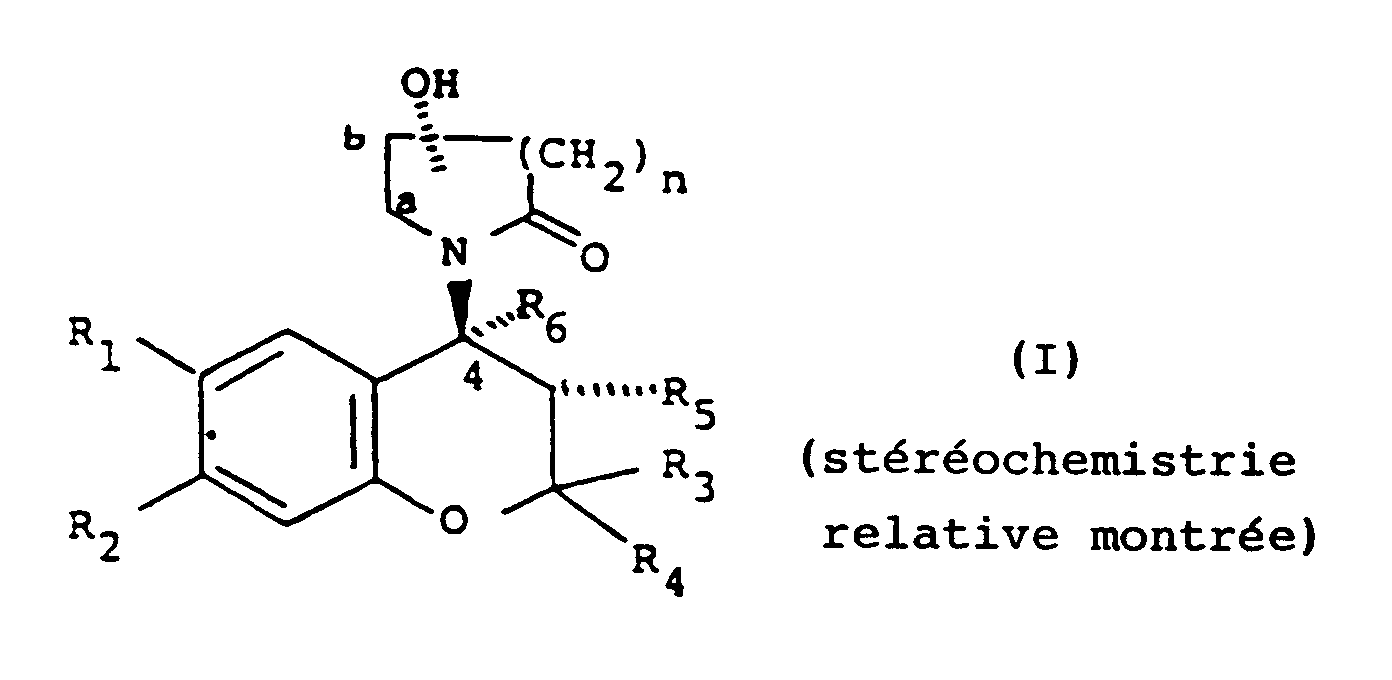
dans laquelle
l'un ou l'autre des R₁ et R₂ est un atome d'hydrogène et l'autre est choisi dans la classe des groupes alkyl(C₁₋₆)-carbonyle, alcoxy(C₁₋₆)carbonyle, alkyl(C₁₋₆)carbonyloxy, alkyl(C₁₋₆)hydroxyméthyle, nitro, cyano, atome de chlore, groupe trifluorométhyle, alkyl(C₁₋₆)sulfinyle, alkyl(C₁₋₆)sulfonyle, alcoxy(C₁₋₆)sulfinyle, alcoxy(C₁₋₆)sulfonyle, alkyl(C₁₋₆)carbonylamino, alcoxy(C₁₋₆)carbonylamino, alkyl(C₁₋₆)thiocarbonyle, alcoxy(C₁₋₆)thiocarbonyle, alkyl(C₁₋₆)thiocarbonyloxy, 1-mercapto-alkyle en C₂₋₇ , formyle, ou aminosulfinyle, aminosulfonyle ou aminocarbonyle, la partie amino étant éventuellement substituée par un ou deux groupes alkyle en C₁₋₆ , ou alkyl(C₁₋₆)sulfinylamino, alkyl(C₁₋₆)sulfonylamino, alcoxy(C₁₋₆)sulfinylamino ou alcoxy(C₁₋₆)sulfonylamino, ou éthylényle substitué en position terminale par un groupe alkyl(C₁₋₆)carbonyle, nitro ou cyano ou -C(alkyle en C₁₋₆)NOH ou -C(alkyle en C₁₋₆)NNH₂ ou bien l'un des R₁ et R₂ est un groupe nitro, cyano ou alkyl(C₁₋₃)carbonyle et l'autre est un groupe méthoxy ou amino éventuellement substitué par un ou deux groupes alkyle en C₁₋₆ ou par un groupe alcanoyle en C₂₋₇ ;
l'un des R₃ et R₄ est un atome d'hydrogène ou un groupe alkyle en C₁₋₄ et l'autre est un groupe alkyle en C₁₋₄ ou bien R₃ et R₄ forment ensemble un radical polyméthylène en C₂₋₅ ;
soit R₅ est un atome d'hydrogène, un groupe hydroxy, alcoxy en C₁₋₆ ou acyloxycarboxylique en C₁₋₇ et R₆ est un atome d'hydrogène, soit R₅ et R₆ forment ensemble une liaison ; et
n est 1 ou 2 ;
le groupe hydroxy substituant le groupe lactame est autre qu'en position alpha ; et le groupe lactame substitué étant trans par rapport au groupe R₅ lorsque R₅ est un groupe hydroxy, alcoxy en C₁₋₆ ou acyloxy en C₁₋₇ ; ou sel de celui-ci acceptable du point de vue pharmaceutique.
dans laquelle
l'un ou l'autre des R₁ et R₂ est un atome d'hydrogène et l'autre est choisi dans la classe des groupes alkyl(C₁₋₆)-carbonyle, alcoxy(C₁₋₆)carbonyle, alkyl(C₁₋₆)carbonyloxy, alkyl(C₁₋₆)hydroxyméthyle, nitro, cyano, atome de chlore, groupe trifluorométhyle, alkyl(C₁₋₆)sulfinyle, alkyl(C₁₋₆)sulfonyle, alcoxy(C₁₋₆)sulfinyle, alcoxy(C₁₋₆)sulfonyle, alkyl(C₁₋₆)carbonylamino, alcoxy(C₁₋₆)carbonylamino, alkyl(C₁₋₆)thiocarbonyle, alcoxy(C₁₋₆)thiocarbonyle, alkyl(C₁₋₆)thiocarbonyloxy, 1-mercapto-alkyle en C₂₋₇ , formyle, ou aminosulfinyle, aminosulfonyle ou aminocarbonyle, la partie amino étant éventuellement substituée par un ou deux groupes alkyle en C₁₋₆ , ou alkyl(C₁₋₆)sulfinylamino, alkyl(C₁₋₆)sulfonylamino, alcoxy(C₁₋₆)sulfinylamino ou alcoxy(C₁₋₆)sulfonylamino, ou éthylényle substitué en position terminale par un groupe alkyl(C₁₋₆)carbonyle, nitro ou cyano ou -C(alkyle en C₁₋₆)NOH ou -C(alkyle en C₁₋₆)NNH₂ ou bien l'un des R₁ et R₂ est un groupe nitro, cyano ou alkyl(C₁₋₃)carbonyle et l'autre est un groupe méthoxy ou amino éventuellement substitué par un ou deux groupes alkyle en C₁₋₆ ou par un groupe alcanoyle en C₂₋₇ ;
l'un des R₃ et R₄ est un atome d'hydrogène ou un groupe alkyle en C₁₋₄ et l'autre est un groupe alkyle en C₁₋₄ ou bien R₃ et R₄ forment ensemble un radical polyméthylène en C₂₋₅ ;
soit R₅ est un atome d'hydrogène, un groupe hydroxy, alcoxy en C₁₋₆ ou acyloxycarboxylique en C₁₋₇ et R₆ est un atome d'hydrogène, soit R₅ et R₆ forment ensemble une liaison ; et
n est 1 ou 2 ;
le groupe hydroxy substituant le groupe lactame est autre qu'en position alpha ; et le groupe lactame substitué étant trans par rapport au groupe R₅ lorsque R₅ est un groupe hydroxy, alcoxy en C₁₋₆ ou acyloxy en C₁₋₇ ; ou sel de celui-ci acceptable du point de vue pharmaceutique.
2. Composé suivant la revendication 1, dans lequel R₁ est un groupe nitro, cyano ou alkyl(C₁₋₃)carbonyle
et R₂ est un atome d'hydrogène.
3. Composé suivant la revendication 1 ou la revendication 2, dans lequel R₃ et R₄ sont
tous deux des groupes méthyle.
4. Composé suivant l'une quelconque des revendications 1, 2 ou 3, dans lequel R₅ est
un groupe hydroxy et R₆ est un atome d'hydrogène.
5. Composé suivant l'une quelconque des revendications 1 à 4, dans lequel le substituant
hydroxy sur le cycle lactame est en position 3 ou 4 par rapport à l'atome d'azote
du groupe lactame, et n est 1.
6. Composé suivant la revendication 1 qui est
le (±)-trans-6-cyano-3,4-dihydro-2,2-diméthyl-4-(3α - hydroxy-2-oxo-1-pyrrolidinyl)-2H-1-benzopyran-3-ol ;
le (±)-trans-6-cyano-3,4-dihydro-2,2-diméthyl-4-(4α - hydroxy-2-oxo-1-pyrrolidinyl)-2H-1-benzopyran-3-ol ou l'isomère (-) unique de ceux-ci.
le (±)-trans-6-cyano-3,4-dihydro-2,2-diméthyl-4-(3α - hydroxy-2-oxo-1-pyrrolidinyl)-2H-1-benzopyran-3-ol ;
le (±)-trans-6-cyano-3,4-dihydro-2,2-diméthyl-4-(4α - hydroxy-2-oxo-1-pyrrolidinyl)-2H-1-benzopyran-3-ol ou l'isomère (-) unique de ceux-ci.
7. Composé suivant l'une quelconque des revendications 1 à 6 sous forme acceptable du
point de vue pharmaceutique.
8. Procédé pour la préparation d'un composé suivant la revendication 1, lequel procédé
comprend (i) la réaction d'un composé de formule (II) :
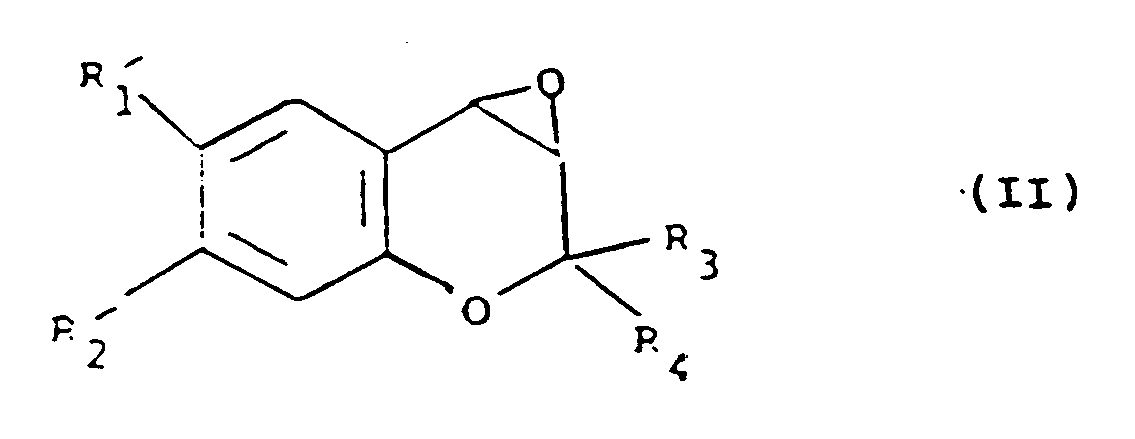
avec un anion de formule (III) :
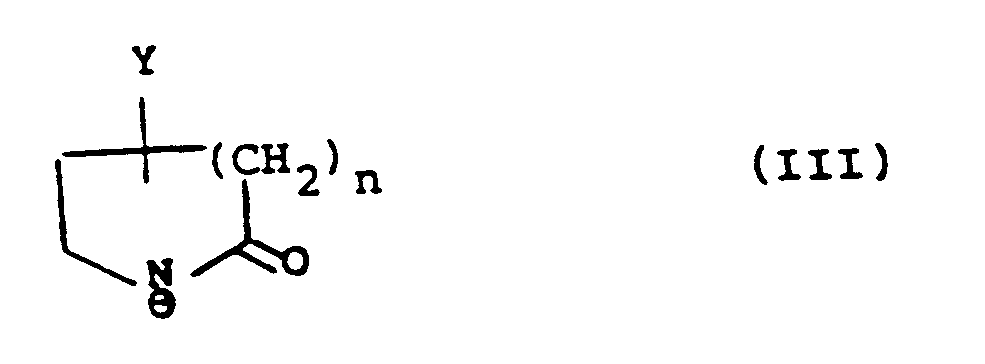
dans lesquelles Y est un groupe hydroxy, hydroxy protégé ou oxo ; R₁' est R₁ tel que défini dans la revendication 1, ou un groupe ou atome pouvant être converti en celui-ci, R₂' est R₂ tel que défini dans la revendication 1, ou un groupe ou atome pouvant être converti en celui-ci, et R₃ , R₄, R₅ et R₆ sont tels que définis dans la revendication 1, et ensuite, la conversion de Y lorsqu'il s'agit d'un groupe hydroxy protégé en un groupe hydroxy ou la réduction de Y lorsqu'il s'agit d'un groupe oxo en un groupe hydroxy ;
ou (ii) (lorsque le substituant hydroxy sur le cycle lactame est en position bêta comme cela est représenté dans la formule (I)), la réaction d'un composé de formule (II) avec NH₃ pour donner un composé de formule (IV) :
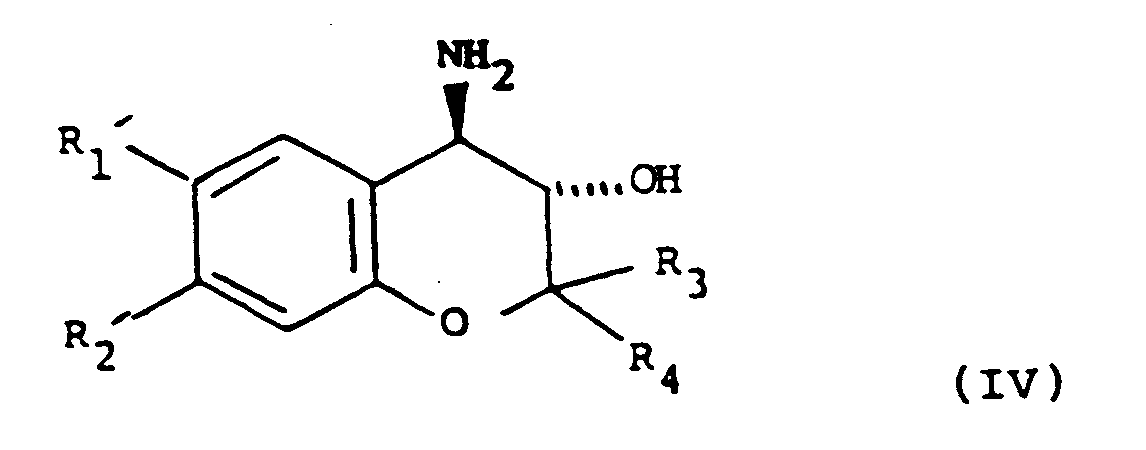
dans laquelle les groupes variables sont tels que définis dans la revendication 1, et ensuite la réaction du composé de formule (IV) avec un composé de formule (V) :

dans laquelle n est tel que défini dans la revendication 1 ; et ensuite, dans le cas où R₁' est un groupe ou atome pouvant être converti en R₁ , la conversation du groupe ou de l'atome en R₁ , dans le cas où R₂' est un groupe ou atome pouvant être converti en R₂ , la conversion du groupe ou de l'atome en R₂ ; la conversion éventuelle de R₁ ou R₂ dans le composé résultant de formule (I) en d'autres R₁ ou R₂ ; la conversion éventuelle du composé résultant de formule (I) dans laquelle R₅ est un groupe hydroxy et R₆ est un atome d'hydrogène en un autre composé de formule (I) dans laquelle R₅ est un groupe alcoxy en C₁₋₆ ou acyloxy en C₁₋₇ et R₆ est un atome d'hydrogène, ou la déshydratation éventuelle du composé résultant de formule (I), dans laquelle R₅ est un groupe hydroxy et R₆ est un atome d'hydrogène, de façon à obtenir le composé correspondant de formule (I), dans laquelle R₅ et R₆ forment ensemble une liaison, et la réduction éventuelle du composé de formule (I), dans laquelle R₅ et R₆ forment ensemble une liaison de façon à obtenir le composé correspondant de formule (I) dans laquelle R₅ et R₆ sont tous deux un atome d'hydrogène ; et la formation éventuelle d'un sel ou solvate acceptable du point de vue pharmaceutique.
avec un anion de formule (III) :
dans lesquelles Y est un groupe hydroxy, hydroxy protégé ou oxo ; R₁' est R₁ tel que défini dans la revendication 1, ou un groupe ou atome pouvant être converti en celui-ci, R₂' est R₂ tel que défini dans la revendication 1, ou un groupe ou atome pouvant être converti en celui-ci, et R₃ , R₄, R₅ et R₆ sont tels que définis dans la revendication 1, et ensuite, la conversion de Y lorsqu'il s'agit d'un groupe hydroxy protégé en un groupe hydroxy ou la réduction de Y lorsqu'il s'agit d'un groupe oxo en un groupe hydroxy ;
ou (ii) (lorsque le substituant hydroxy sur le cycle lactame est en position bêta comme cela est représenté dans la formule (I)), la réaction d'un composé de formule (II) avec NH₃ pour donner un composé de formule (IV) :
dans laquelle les groupes variables sont tels que définis dans la revendication 1, et ensuite la réaction du composé de formule (IV) avec un composé de formule (V) :
dans laquelle n est tel que défini dans la revendication 1 ; et ensuite, dans le cas où R₁' est un groupe ou atome pouvant être converti en R₁ , la conversation du groupe ou de l'atome en R₁ , dans le cas où R₂' est un groupe ou atome pouvant être converti en R₂ , la conversion du groupe ou de l'atome en R₂ ; la conversion éventuelle de R₁ ou R₂ dans le composé résultant de formule (I) en d'autres R₁ ou R₂ ; la conversion éventuelle du composé résultant de formule (I) dans laquelle R₅ est un groupe hydroxy et R₆ est un atome d'hydrogène en un autre composé de formule (I) dans laquelle R₅ est un groupe alcoxy en C₁₋₆ ou acyloxy en C₁₋₇ et R₆ est un atome d'hydrogène, ou la déshydratation éventuelle du composé résultant de formule (I), dans laquelle R₅ est un groupe hydroxy et R₆ est un atome d'hydrogène, de façon à obtenir le composé correspondant de formule (I), dans laquelle R₅ et R₆ forment ensemble une liaison, et la réduction éventuelle du composé de formule (I), dans laquelle R₅ et R₆ forment ensemble une liaison de façon à obtenir le composé correspondant de formule (I) dans laquelle R₅ et R₆ sont tous deux un atome d'hydrogène ; et la formation éventuelle d'un sel ou solvate acceptable du point de vue pharmaceutique.
9. Composition pharmaceutique comprenant un composé suivant l'une quelconque des revendications
1 à 7, et un support acceptable du point de vue pharmaceutique.
10. Utilisation d'un composé suivant l'une quelconque des revendications 1 à 7 dans la
fabrication d'un médicament pour le traitement de l'hypertension et /ou d'une insuffisance
cardiaque congestive et/ou d'une angine de poitrine et/ou d'une maladie vasculaire
périphérique et/ou d'une maladie vasculaire cérébrale et/ou de maladies associées
à la contraction du muscle lisse des voies gastro-intestinales et/ou du système respiratoire
et/ou de l'utérus et/ou des voies urinaires.
